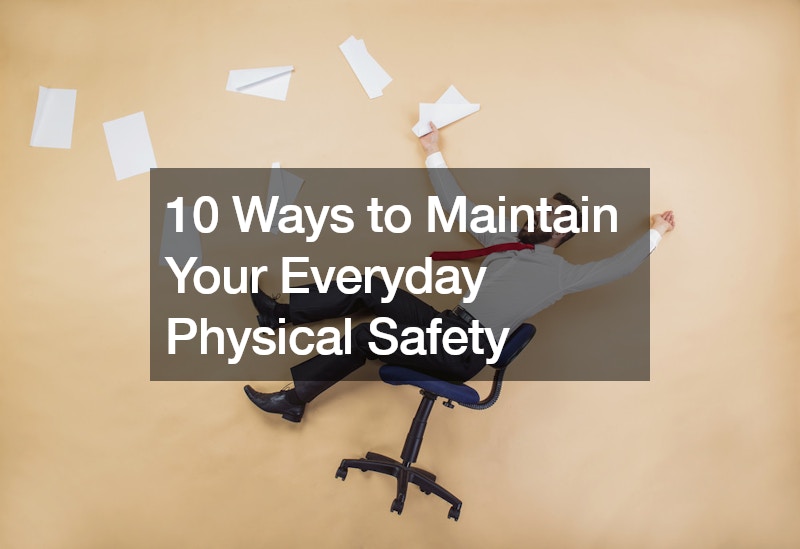
10 Ways to Maintain Your Everyday Physical Safety
In today’s fast-paced world, prioritizing your everyday physical safety is crucial. Safety isn’t just about avoiding accidents—it’s about creating a worry-free environment where you can thrive. This article explores enhancing everyday safety, from advanced equipment to legal aid. Let’s delve into this vital topic together. Your safety matters, so let’s take it seriously.
1. Understanding the Role of Advanced Equipment in Ensuring Safety

When it comes to your everyday physical safety, advanced equipment plays a key role. Let’s take a moment to consider FC proliner mill liners for rod mills. These aren’t something you’d typically associate with daily safety, right? But here’s the thing—they’re designed to protect the interior of rod mills from wear and tear, which reduces the risk of machinery failure.
You might be thinking, ‘What does this have to do with my safety?’ Well, imagine you’re working in an industry that uses these mills. If a mill fails, it could lead to accidents or even halt production—putting jobs at risk. So, in a way, these liners indirectly contribute to maintaining your physical safety and job security.
But it doesn’t stop there. Advanced equipment isn’t just about heavy machinery. It extends to items you use daily. Think about the smart home systems that alert you to intruders or smoke detectors that warn you of potential fires. They’re all part of a network of devices designed to keep you safe.
2. Staying Connected: The Importance of Reliable Communication Tools
Have you ever considered how vital a good cell phone signal is for your everyday physical safety? It’s easy to take for granted, but it’s truly crucial. Imagine you’re on a road trip, and your car breaks down in an area with poor cell service. A cell phone signal strength test can be a lifesaver in such scenarios, helping you pinpoint the best location to make that essential call for help.
But staying connected is not just about emergencies. It also means regularly reaching out to friends and family. It offers a sense of security, knowing you can check in with your loved ones or they can reach you whenever needed.
Good communication tools go beyond just cell phones. Think about the internet, social media platforms, and your home landline. They all contribute to keeping you safe and connected. For instance, navigation apps guide you safely to your destination, while neighborhood community forums keep you updated on local safety issues.
3. The Impact of Technological Innovations on Safety Measures

When you consider technological innovations, there’s no denying their incredible impact on your everyday physical safety. Have you ever heard of a remote vibration sensor? It’s a nifty gadget that can detect unusual vibrations in your surroundings.
Now, let’s put this into context. Say you live in an area prone to earthquakes. A remote vibration sensor could give you those precious few seconds of warning before a quake hits. It’s not a massive leap, but those seconds could be the difference between reaching safety.
But it’s not just about natural disasters. These sensors can also detect potential intruders or alert you to structural issues in your home. That’s the beauty of technology—it’s versatile and adaptable to different safety needs.
And the innovation doesn’t stop there. Technology continues to revolutionize our approach to safety, from wearable tech that monitors your health to smart locks that secure your home. Even something as commonplace as a car now has advanced safety features like automatic braking systems and blind spot detection.
So, technological innovations continually enhance our safety measures, whether it’s a remote vibration sensor or a smartwatch. They’re not just convenient—they’re lifesavers. So, let’s embrace these advancements and make them part of our daily lives. After all, when it comes to safety, every bit counts.
4. Transportation Safety: What You Need to Know
Transportation plays a huge role in everyday physical safety. Have you ever considered the safety aspects of car trailers? They’re not just a convenience for hauling extra stuff on road trips—they’re key to ensuring safe travel.
Let’s dig into this a bit. Properly loaded and balanced car trailers protect your belongings and prevent dangerous situations on the road. An improperly secured load can cause swaying or tipping, putting you and other road users at risk.
But safety in transportation isn’t just about car trailers. It’s about the whole package. From the seatbelts we fasten without thinking to the traffic laws we abide by—every aspect contributes to safer journeys.
Consider also the technological advancements in vehicles today. Features like rearview cameras, lane-keeping assist, and automatic emergency braking create a safer driving environment. Even simple things like good tire maintenance can significantly impact your safety on the road.
So, whether it’s ensuring your car trailer is secure or keeping up with regular vehicle maintenance, every action contributes to your safety in transportation. It’s about being aware, staying informed, and making smart choices. Because when you’re on the road, your safety—and the safety of others—is in your hands.
5. Promoting Safety through Adaptive Sports Activities

Have you ever considered how adaptive sports activities can boost your everyday physical safety? It’s a fascinating concept. Take adaptive gymnastics, for example. It’s not just about getting fit—it’s about learning how to move your body safely and effectively.
Let’s get into the specifics here. Adaptive gymnastics can teach you how to fall correctly, minimizing the risk of injury. Sounds simple, right? But it’s a skill that can come in handy in real-life situations, like tripping on a sidewalk or slipping in the kitchen.
However, the benefits of adaptive sports activities go beyond physical safety. They also foster mental well-being. Staying active helps relieve stress and boosts mood, both vital for overall health.
Think about it. When you’re physically fit and mentally strong, you can better handle life’s challenges- an unexpected fall or a stressful situation. That’s where adaptive sports activities come into play.
Of course, adaptive gymnastics is just one example. There are countless other adaptive sports activities, each offering unique benefits. From wheelchair basketball to adaptive yoga, there’s something for everyone.
So, whether it’s practicing safe falls in adaptive gymnastics or building strength in adaptive rowing, these activities are more than just sports. They’re avenues to promote safety and well-being in our daily lives. And that’s something worth investing in.
6. How Healthcare Professionals Contribute to Daily Safety
Have you ever considered healthcare professionals’ role in your everyday physical safety? It’s a thought worth pondering. For instance, think about your local pharmacist. They do more than just hand out prescriptions—they’re a critical link in your health and safety chain.
Let’s delve into this a bit. A pharmacist can spot potential drug interactions that could put your health at risk. They can also guide safe medication use, preventing harmful side effects. These are crucial aspects of maintaining your well-being.
But it’s not just about pharmacists. All healthcare professionals contribute to your daily safety in their unique ways. Doctors diagnose and treat illnesses, preventing complications. Nurses monitor your health and provide care, ensuring your comfort and recovery.
Even behind-the-scenes roles, like lab technicians, play a part. They conduct tests that help in accurate diagnosis and treatment. Each role contributes to your safety and well-being, whether big or small. Consider also the mental health professionals who help manage stress, anxiety, and other mental health issues. They play a pivotal role in maintaining your overall well-being and resilience.
So, whether it’s your friendly neighborhood pharmacist or your trusted family doctor, healthcare professionals are unsung heroes in promoting our daily safety. Their expertise and dedication ensure we can live with less worry and more peace of mind. It’s a reminder that safety is a communal effort, and we all have our part to play.
7. Maintaining Oral Health for Overall Well-being
Have you ever considered how oral health relates to your everyday physical safety? It’s an angle often overlooked. Let’s take the example of therapeutic dentistry. It’s not just about a pretty smile—it’s also about maintaining overall health and preventing potential complications.
Let’s dig a little deeper. A restorative dentistry service can address issues such as cavities and gum disease. If left untreated, these can lead to more serious health problems, like heart disease or stroke. So, regular dental check-ups aren’t just for keeping your teeth sparkling—they’re crucial for your well-being.
But it’s not just about restorative services. Preventive measures play a huge part, too. Regular brushing, flossing, and healthy eating habits contribute to oral health. These simple daily routines can help prevent the need for more invasive procedures.
Consider orthodontics’ role in promoting safety. Misaligned teeth or a bad bite can cause difficulties in chewing and speaking. By correcting these issues, orthodontics can prevent accidents and improve quality of life.
8. The Contribution of Skilled Craftsmen to Everyday Safety
Ever thought about how skilled craftsmen contribute to your everyday physical safety? It may not be the first thing that comes to mind. Take tailors, for instance. They’re not just about creating beautiful clothes—they also play a role in ensuring our comfort and safety.
Let’s get into the details here. Tailors can make adjustments to our clothes so they fit just right. This isn’t merely about looking good. Clothes that fit properly won’t restrict movement or cause discomfort, reducing the risk of accidents.
But it’s not just about tailors. All kinds of craftsmen contribute to our daily safety in their unique ways. Carpenters create sturdy furniture that won’t collapse under weight. Electricians ensure our homes are wired safely, preventing electrical fires.
Consider also the craftsmen who work on our roads and buildings. Construction workers, masons, and plumbers ensure our environments are safe to live and work in. Their skills and dedication help prevent accidents and maintain our well-being.
So, whether it’s getting your clothes altered by a tailor or having a carpenter build a durable bookshelf, skilled craftsmen play a significant role in our everyday physical safety. Their work, while often behind the scenes, is integral to our daily lives. It’s a reminder that safety comes from all corners, and we owe much of it to the skilled hands that shape our world.
9. Navigating Legal Aid for Personal Safety Incidents

Have you ever considered the role of legal aid in maintaining your everyday physical safety? It’s an aspect that might not be immediately obvious. Let’s take personal injury attorneys, for example. They’re not just there to argue in court—they can also be instrumental in navigating personal safety incidents.
Let’s unpack this a bit. Personal injury attorneys can help you understand your rights and the steps to take following an accident or injury. This guidance isn’t just about seeking compensation—it’s also about ensuring your ongoing safety and well-being.
But legal aid is not just about personal injury attorneys. Legal aid can come in many forms, contributing to our daily safety. Family lawyers can assist in cases of domestic violence, helping to secure protective orders. Employment lawyers can address workplace safety issues, advocating for safer conditions.
Consider also the role of legal aid organizations. They provide free or low-cost services to those who can’t afford a lawyer. This access to justice is crucial in maintaining safety and well-being for all, regardless of income.
10. Home Safety: The Role of Proper Heating Systems
Have you ever considered how your home’s heating system affects your everyday physical safety? It might not be the first thing that springs to mind. Let’s discuss heating oil, for instance. It’s not just about keeping you warm—it also plays a key role in maintaining a safe home environment.
Let’s delve into this. Proper utilization of heating oil can ensure consistent, reliable warmth throughout your home. This isn’t just about comfort—it’s also about preventing health issues related to cold, such as hypothermia or frostbite.
But it’s not just about heating oil. All aspects of your heating system contribute to safety. Regular maintenance checks can prevent malfunctions that could lead to dangerous situations, like carbon monoxide leaks or fires. Consider also the role of insulation in your home. A well-insulated house can retain heat more effectively, reducing the need for excessive heating and lowering the risk of overheating. Plus, it can save you money on heating bills.
Ensuring your everyday physical safety isn’t one-size-fits-all. It’s about being aware of your surroundings, making informed choices, and taking proactive steps. Skilled craftsmen, legal help, and home heating all keep you safe. Let’s stay alert, apply these lessons, and prioritize safety for a fulfilling life. Stay safe and vigilant; remember your well-being hinges on your everyday safety.

